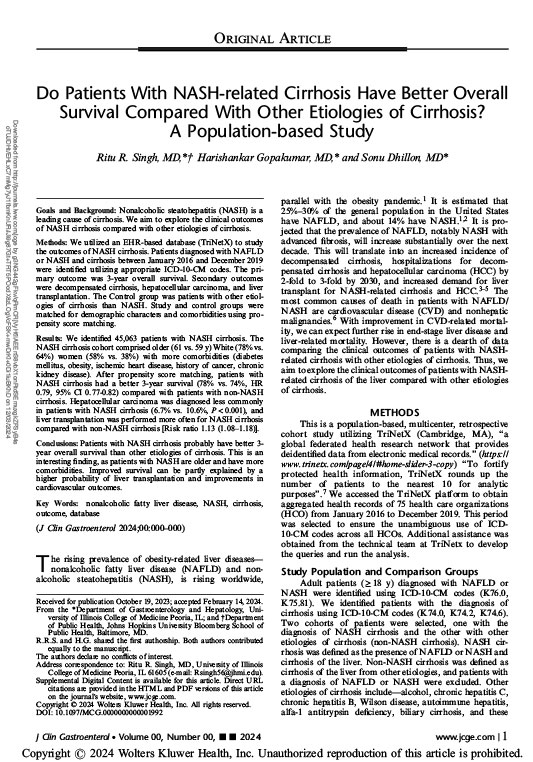Do Patients With NASH-related Cirrhosis Have Better Overall Survival Compared With Other Etiologies of Cirrhosis? A Population-based Study
May 2024
Journal of Clinical Gastroenterology
Goals and Background: Nonalcoholic steatohepatitis (NASH) is a leading cause of cirrhosis. We aim to explore the clinical outcomes of NASH cirrhosis compared with other etiologies of cirrhosis.
Methods: We utilized an EHR-based database (TriNetX) to study the outcomes of NASH cirrhosis. Patients diagnosed with NAFLD or NASH and cirrhosis between January 2016 and December 2019 were identified utilizing appropriate ICD-10-CM codes. The primary outcome was 3-year overall survival. Secondary outcomes were decompensated cirrhosis, hepatocellular carcinoma, and liver transplantation. The Control group was patients with other etiologies of cirrhosis than NASH. Study and control groups were matched for demographic characters and comorbidities using propensity score matching.
Results: We identified 45,063 patients with NASH cirrhosis. The NASH cirrhosis cohort comprised older (61 vs. 59 y) White (78% vs. 64%) women (58% vs. 38%) with more comorbidities (diabetes mellitus, obesity, ischemic heart disease, history of cancer, chronic kidney disease). After propensity score matching, patients with NASH cirrhosis had a better 3-year survival (78% vs. 74%, HR 0.79, 95% CI 0.77-0.82) compared with patients with non-NASH cirrhosis. Hepatocellular carcinoma was diagnosed less commonly in patients with NASH cirrhosis (6.7% vs. 10.6%, P<0.001), and liver transplantation was performed more often for NASH cirrhosis compared with non-NASH cirrhosis [Risk ratio 1.13 (1.08–1.18)].
Conclusions: Patients with NASH cirrhosis probably have better 3- year overall survival than other etiologies of cirrhosis. This is an interesting finding, as patients with NASH are older and have more comorbidities. Improved survival can be partly explained by a higher probability of liver transplantation and improvements in cardiovascular outcomes.


